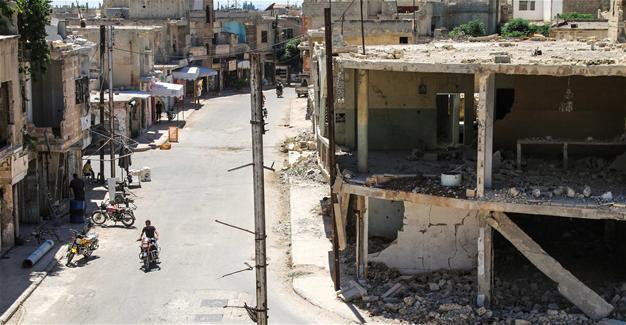Heaviest clashes for months hit Syria’s Hama province
BEIRUT – Reuters
 The heaviest fighting and shelling for months hit Hama province in northern Syria on Aug. 4, a war monitor said, but there were diverging accounts of how the battle started.
The heaviest fighting and shelling for months hit Hama province in northern Syria on Aug. 4, a war monitor said, but there were diverging accounts of how the battle started.The clashes were accompanied by heavy bombardment, with dozens of shells and rockets being fired, said the Britain-based Syrian Observatory for Human Rights, adding that it had confirmed there had been casualties.
The battle is around the village of Maan, 23 kms north of Hama in western Syria, near the location of a rebel assault and government counter-offensive this spring.
The Observatory said the fighting arose from an attempt by pro-government forces to advance north from Maan into rebel territory.
A military media unit run by the government’s ally Hezbollah, a Lebanese Shiite group, said it was rebels who tried to attack, but were thwarted by the Syrian army.
Hardline Islamist groups, including the Tahrir al-Sham alliance which contains al-Qaeda’s former Syrian affiliate, are present in the area.
The war front in northern Hama province has mostly been quiet since a de-escalation process, brokered by Russia and Turkey took effect in early May.
The Syrian army’s main focus since May has been its campaign in the east of the country against Islamic State of Iraq and the Levant (ISIL).
Meanwhile, warring sides exchanged rocket and gunfire north of the Syrian city of Homs overnight, hours after a Russia-backed truce took effect, Observatory said on Aug. 4, while heavy rocket fire also marred a similar deal east of the capital Damascus.
Russia said on Aug. 3 its defense ministry and Syria’s opposition had agreed to set up a “de-escalation” zone in the rebel-held countryside north of government-held Homs.
After an initial few hours of calm, the rebels and government forces and their allies began to target each other’s territory.
The Russia-backed truce was similar to a de-escalation deal worked out in July for the besieged Eastern Ghouta rebel enclave east of Damascus.
Despite the deal and some reduction in violence, air strikes, rockets and exchanges of fire have continued to hit Eastern Ghouta.
The Syrian Observatory said since the Eastern Ghouta truce was declared on July 22 it had recorded at least 25 civilian deaths, including seven children, and dozens of injuries. Russia said it had deployed its military police in Eastern Ghouta in July to try to enforce the de-escalation zone.
Eastern Ghouta, the only major rebel-held area near the capital, has been blockaded by Syrian government forces since 2013. It has shrunk considerably in size over the past year as the Russia-backed Syrian army has taken control of other rebel-held areas around Damascus.
The Observatory said on Aug. 4 around 70 rockets had fallen in 24 hours on Eastern Ghouta in the heaviest bombing since the de-escalation zone was declared.
Several attempts at a lasting cease-fire in western Syria, where rebels have lost ground to government forces and their allies, have collapsed with both sides blaming the other for outbreaks of violence.
















